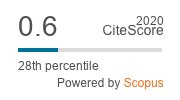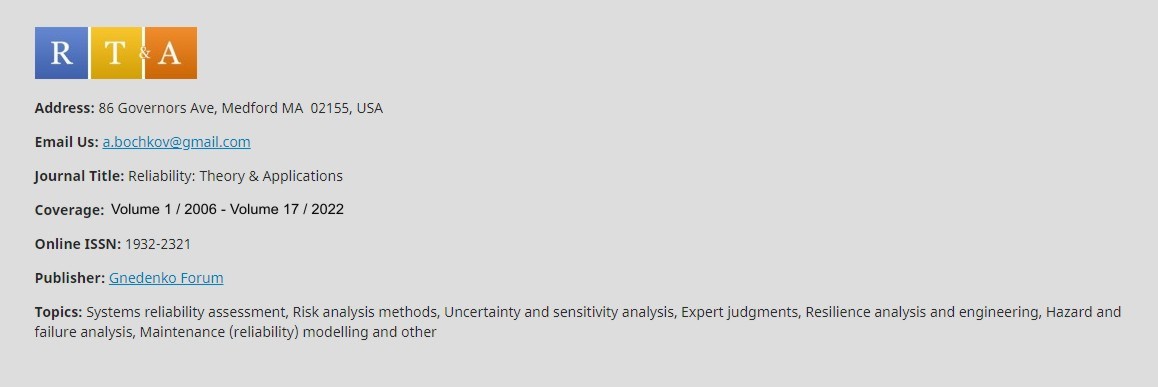Aditya Tiwary, Swati Tiwary
An Innovative Methodology for Evaluation of
Reliability Indices of Electric Traction System
Evaluation of reliability is most important when we
have to check the availability of supply in any
electric power system. The basic reliability index
which is of importance is failure rate, repair time
and unavailability of the supply in any electric
power system. In this paper evaluation of various
basic reliability indices for the electric traction
system is done. Electric traction system is very
important as it is used for operation of passenger
trains and freight trains across a large rail
network throughout the world. As the traction system
is very important therefore reliability evaluation
of its various parameters are essential for proper
and uninterrupted working of the whole electric
traction system.

DOI: https://doi.org/10.24412/1932-2321-2021-262-13-21
V.V. Singh, P. K. Poonia, Jibril Umar Labaran,
Ibrahim Abdullahi
Probabilistic analysis of a multi-state warm standby
k-out-of-n: G system in a series configuration using
copula linguists
This paper discusses the reliability analysis
of repairable complex system comprising of two
subsystems in
series configuration together with the
controllers. The two subsystems, consisting of three
undistinguishable units in a parallel arrangement
and functioning under 1-out-of-3: G operational
policy. Controllers control
both the subsystems and can be unstable, and
the malfunction result in the controller prevents
system operation. The system may have an
unforeseeable catastrophic failure due to which the
system may not perform
its function once the situation arises. The
failure rate of the units is constant, and the
exponential distribution is assumed to obey. The two
forms of repair namely general repair and
Goumbel-Hougard copula repair are used to restore
the existing failed units of the system. The
supplementary variable technique with Laplace
transformation is used to evaluate the output
of the system. Using Stochastic theory, differential
equations are derived to obtain essential features
of reliability such as availability of the system,
reliability of the system,
MTTF, and profit analysis. Graphs were drawn
to highlight the behavior of the results. Tables and
figures display the findings and suggest that copula
repair is a more efficient repair policy for the
improved performance of repairable systems. It
brings a different aspect to the research world to
adopt multi-dimensional repair in the form of the
copula. Besides, the findings of the model are
useful for system engineers and maintenance
managers.

DOI: https://doi.org/10.24412/1932-2321-2021-262-22-39
Gurami Tsitsiashvili, Yuriy Kharchenko
Digitalization of Information Specified on the Grid
Digitalization is the process of implementing
digital transmission systems at the level of primary
networks,
switching and control facilities that ensure
the transmission and distribution of information
flows in digital
form at the level of secondary networks,
which makes production more flexible, competitive,
and profitable. First point considered here is an
introduction of mathematical equivalent to the
concept of a pixel, used when replacing the original
information with its step-by-step approximation and
estimate of its accuracy. Second point is the study
of special knots: extreme knots or saddle knots on
the grid and construction of level lines around
them: ellipses or hyperbolas. This construction is
connected with some meteorological problems and is
based on the concept of positive definite
quadratic form. Third point is an estimation of the
average number of Poisson flow points in several
cells of a square lattice in different problems of
earth sciences. It is solved by introduction of
relative error of the estimate.

DOI: https://doi.org/10.24412/1932-2321-2021-262-40-44
Intekhab Alam, Mohd Asif Intezar, Aquil Ahmed
Costs of Maintenance Service Policy: a New Approach
on Constant Stress Partially Accelerated Life Test
for Generalized Inverted Exponential Distribution
In this paper, we describe how to analyze and
propose the accelerated life test plans for the
development of the
excellence and reliability of the product. We
focus on estimating the costs of maintenance service
policy because
it has a very significant position to assist
any manufacturing organization for sale and
available its equipment
and maintenance cost-effective. The
constant-stress partially accelerated life test is
assumed when the lifetime of test units follows
Generalized Inverted Exponential distribution under
the progressive censoring scheme. The maximum
likelihood estimates, Fisher Information matrix, and
the asymptotic variance and covariance matrix are
obtained. The confidence intervals of the estimators
are also obtained. Furthermore, a simulation study
is conducted to check the accuracy of the findings.

DOI: https://doi.org/10.24412/1932-2321-2021-262-45-57
Gauthami P., Chacko V. M.
Dus Transformation of Inverse Weibull Distribution:
An Upside-Down Failure Rate Model
A new upside-down bathtub shaped failure rate
distribution, DUS Inverse Weibull (DUS-IW)
distribution is
proposed and its properties are studied. The
DUS-IW distribution has upside-down bathtub shaped
and decreasing failure rate functions. Moments,
moment generating function, characteristic function,
quantiles, etc. are derived. Estimation of
parameters of the distribution is performed via
maximum likelihood method. Reliability of single
component and multi component stress-strength models
are derived. A simulation study is
performed for validating the estimates of the
model parameters. DUS-IW distribution is applied to
two real data sets and found that DUS-IW
distribution is a better fit than other well-known
distributions.

DOI: https://doi.org/10.24412/1932-2321-2021-262-58-71
Abdul Alim, Diwakar Shukla
Double Sampling Based Parameter Estimation in Big
Data and Application in Control Charts
Double sampling technique and control charts are
used for predicting about unknown parameters of the
big population and developing algorithms for
imposing control over growth factor. This sampling
procedure has two approaches like sub-sample and
independent sample. Aim is to estimate mean
file-size by both and to find out which approach is
better in big data setup. Comparative mathematical
tools used herein are mean squared error, confidence
interval, relative confidence interval length
measure and control charts of digital file-size for
monitoring. Estimation strategies are proposed and
confidence intervals are computed over multiple
points of time. At each time, it was found that
confidence intervals are catching the true values.
First kind of approach (as case I) of double
sampling found better than the second. A new
simulation strategy is proposed who is observed
efficient for comparison purpose. Single-valued
simulated confidence intervals are obtained using
the new simulation strategy and found covering the
truth in its range. As an application of outcomes,
control
charts are developed to monitor the
parametric growth over long duration. Upper and
Lower control limits are drawn for business managers
to keep a watch on digital file-size estimates
whether their growth under control?
Outcomes may be extended for reliability
evaluation under discrete time domain. The content
herein is a piece
of thought, idea and analysis developed by
deriving motivation from past references to handle
big data using
double sampling. Findings of the study can be
used for developing software based monitoring system
using process control charts for managers.

DOI: https://doi.org/10.24412/1932-2321-2021-262-72-114
Baranov, L.A., Ermolin, Y.A., Shubinsky, I.B.
On a Reliability of Tree-Like Transportation
Networks
The degree of reliability of the
transportation tree-like networks is proposed to be
estimated by the index of operational reliability,
which is the relative volume of the product not
delivered to the point for some time due to the
failures of its elements. A method is proposed for
calculating this index using a characteristic
feature of
the structure of transportation network – a
tree-like structure and assumes the time invariance
of failure and repair flows of its elements. On such
structure, the Y-shaped structure-forming fragment
is distinguished, the
assessment of the reliability of which (in
the accepted understanding) is carried out
analytically using the concept of the state space.
Each of Y-shaped fragment is virtually replaced by
one fictitious element, the
destruction parameter of which is calculated
from the condition of equality of the volumes of the
product undelivered to the network output during
such a replacement. The calculation of the
operational index is reduced to a step-by-step
recurrent procedure using the results obtained in
the previous step.

DOI: https://doi.org/10.24412/1932-2321-2021-262-115-123
S. Adilakshmi, Dr. N. Ravi Shankar
A New Ranking in Hexagonal Fuzzy number by Centroid
of Centroids and Application in Fuzzy Critical Path
This paper intends to introduce a different
ranking approach for obtaining the critical path of
the fuzzy project network. In the network, each
activity time duration is viewed by the fuzzy
hexagonal number. This study proposes an advanced
ranking approach by applying the centroid of the
Hexagonal fuzzy number. The Hexagon is separated
into two right angles and one polygon. By applying
the right angle and polygon centroid formula, we can
calculate the centroid of each plane and calculate
the centroid of the centroid. It also focuses on the
arithmetic operations in Hexagonal fuzzy numbers.
The developed strategy has been described by a
numerical illustration and is correlated with a few
of the existing ranking approaches.

DOI: https://doi.org/10.24412/1932-2321-2021-262-124-135
K.M. Sakthivel, K. Dhivakar
Type II Power Topp-Leone Daggum Distribution With
Application In Reliability
In this paper, we introduce a new continuous
probability distribution named as type II power Topp-Leone
Dagum distribution using the type II power
Topp-Leone generated family studied by Rashad et
al.. We have obtained some
reliability measures like reliability function,
hazard rate function, reversed hazard rate
function, mean waiting time, mean past
life time, mean deviation, second failure rate
function and mean residual
life function. We have derived some statistical
properties of the new probability distribution
including
mean, variance, moments, moment
generating function, characteristics function,
cumulant generating function,
incomplete moments, inverted moments, central
moments, conditional moments, probability weighted
moments and order statistics. For the
probability proposed new probability distribution.
we have obtained some income
inequality measures like Lorenz curve, Bonferroni
index, Zenga index and Generalized entropy. The
maximum likelihood estimation method is used
to estimate the parameters of the probability
distribution.
Finally, the proposed generalized
model is applied to life time data sets to evaluate
the model performance.

DOI: https://doi.org/10.24412/1932-2321-2021-262-136-156
Vladimir Rykov
Decomposable Semi-Regenerative Processes: Review of
Theory and Applications to Queueing and Reliability
Systems
A review of the Smith’s regeneration idea
development is proposed. As a generalization of this
idea the main
definitions and results of
decomposable semi-regenerative processes are
reminded. Their applications for
investigation of various queueing and
reliability systems are considered.

DOI: https://doi.org/10.24412/1932-2321-2021-262-157-190
G. Ayyappan, R. Gowthami
A MAP/PH/1 queue with Setup time, Bernoulli
vacation, Reneging, Balking, Bernoulli feedback,
Breakdown and Repair
A single server classical queueing model with
Markovian Arrival Process (MAP), phase-type(PH)
distributed
service time and rest of the random
variables are distributed exponentially is
investigated. By making use of
matrix analytic method, the resultant QBD
process is examined in the stationary state. The
practical
applicability, objectives and the
uniqueness of our model have been provided. The busy
period analysis has been done
and the distribution function for the waiting time
has also been obtained. Some performance measures
are
enlisted. At last, some graphical and
numerical exemplifications are furnished.

DOI: https://doi.org/10.24412/1932-2321-2021-262-191-221
Md. Asraful Haque, Nesar Ahmad
A Software Reliability Growth Model Considering
Mutual Fault Dependency
Many software reliability growth models (SRGMs)
have been introduced since 1970s. Most of the models
consider that the faults are independent and
debugging method is perfect. In this paper, we
present a new
SRGM under the assumption that the faults are
mutually dependent i.e. repairing a detected fault
may
introduce new faults or it may
simultaneously correct some future faults without
any additional effort. The
model is validated on two real datasets that are
widely used in many studies to demonstrate its
applicability.
The comparisons with eight established
models in terms of Mean Square Error (MSE),
Variance, Predictive Ratio
Risk (PRR) and R2 have been presented.

DOI: https://doi.org/10.24412/1932-2321-2021-262-222-229
Brijesh P. Singh, Utpal Dhar Das, Sandeep Singh
A Compounded Probability Model for Decreasing Hazard
and its Inferential Properties
Early failures are generally observed due to
latent defects within a product caused by faulty
components, faulty
assembly, transportation damage and
installation damage. Also early life (infant
mortality) failures tend to
exhibit a decreasing failure rate over time. Such
type of problems can be modelled either by a complex
distribution having more than one
parameter or by finite mixture of some distribution.
In this article a single
parameter continuous compounded distribution is
proposed to model such type of problems. Some
important properties of the
proposed distribution such as distribution function,
survival function, hazard function and
cumulative hazard function, entropies,
stochastic ordering are derived. The maximum
likelihood estimate of the
parameter is obtained which is not in closed form,
thus iteration procedure is used to obtain the
estimate of parameter. The
moments of the proposed distribution does not exist.
Some real data sets are used to see the
performance of proposed distribution with
comparison of some other competent distributions of
decreasing hazard using
Likelihood, AIC, AICc, BIC and KS statistics.

DOI: https://doi.org/10.24412/1932-2321-2021-262-230-246
Pradeep Chaudhary, Lavi Tyagi
A Two Non-Identical Unit Parallel System Subject to
Two Types of Failure and Correlated Life Times
The paper deals with the reliability and
cost-benefit analysis of a two non-identical unit
system with two types of
failure. The units are named as unit-1 and unit-2
and they are arranged in a parallel configuration.
Unit-1 can fail due to
hardware or due to human error failure whereas
unit-2 fails due to normal cause. A single
repairman is considered with the
system for all types of failure in the units and
unit-1 gets priority in repair
over the unit-2. The repair time
distributions of unit-1 are taken as general with
different c.d.fs and the repair
time distribution of unit-2 is taken
as exponential. Failure time distribution of unit-1
due to human error is
taken exponential. Whereas the random
variable denoting the failure time of unit-1 due to
hardware failure and
random variable denoting the failure
time of unit-2 are assumed to be correlated random
variables having their joint
distribution as bivariate exponential (B.V.E.).

DOI: https://doi.org/10.24412/1932-2321-2021-262-247-258
Ibrahim Yusuf, Abdullahi Sanusi
Optimal System for Five Units Serial Systems under
Partial and Complete Failure
The present paper studies and compared some
reliability characteristics of series-parallel
systems containing
five units each under partial and
complete failure. Four different system
configurations are considered in this
paper. It is assumed that both the failure
and repair rates of each system configuration follow
exponential distribution. The
steady-state availability, busy period of repairman
due to partial and complete failure, profit
function, mean time to failure (MTTF) have
been derived, examined and compared. The system
configurations
are compared analytically in terms of
their availability and mean time to failure (MTTF).
Cost-benefit measure has been
evaluated for all the system configurations. The
computed results are presented in tables and
figures.
From the analysis, system
configuration II is observed to be the optimal
configuration.

DOI: https://doi.org/10.24412/1932-2321-2021-262-259-278
Noura Obeid, Seifedine Kadry
Product Of n Independent Maxwell Random Variables
We derive the exact probability density
functions (pdf) of a product of independent Maxwell
distributed
random variables. The distribution
functions are derived by using an inverse Mellin
transform technique from
statistics, and are given in terms of a special
function of mathematical physics, the Meijer
G-function.

DOI: https://doi.org/10.24412/1932-2321-2021-262-279-288
Haneefa Kausar, Ahmad Yusuf Adhami, Ahmadur Rahman
Quadratic Fractional Bi-level Fuzzy Probabilistic
Programming Problem When bi Follows Exponential
Distribution
Some of the actual life decisions are made in
decentralized manner under uncertainty. This paper
formulates a
quadratic fractional bi-level (QFBL)
programming problem with probabilistic constraints
in both first (leader) and
second level (follower) having two parameter
exponential random variables with known probability
distributions and fuzziness is considered as
triangular and trapezoidal fuzzy number. These fuzzy
numbers of the membership
functions related with the proportional probability
density function has been used to introduce
a defuzzification approach for finding
the crisp values of fuzzy numbers. In the proposed
model the problem is first
converted into an equivalent deterministic quadratic
fractional fuzzy bi level programming model by
applying chance constrained
programming technique. Secondly, in the suggested
model, each objective function
of the bi-level quadratic fractional
programming problem has its own non-linear
membership function. The
fuzzy goal programming (FGP) approach is used to
find a compromise solution for the BLQFP problem.
Finally, to demonstrate the
applicability and performance of the proposed
approach an illustrative numerical
example is given.

DOI: https://doi.org/10.24412/1932-2321-2021-262-289-300







.png)
.png)
